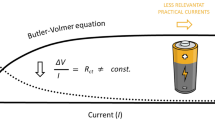Abstract
With the development of functional materials with high ionic and combined ionicelectronic conductivity, the engineering of interfaces became prerequisite. Technological applications demand combinations of materials with different electrical properties to form junctions. The occurring kinetic electrode phenomena play a significant role to the overall performance and may be rate determining. We show here the significance of the equilibration between platinum and the solid electrolyte with respect to the response time in potentiometric oxygen sensors. Fundamental aspects of voltage generation are discussed as well, and the response time is correlated to the equilibration along the contact zone between platinum and the electrolyte. A common problem of potentiometric devices for gas sensing applications is the cross sensitivity to species other than those under detection. The proposed kinetic method based on the theta concept is investigated for selective detection in the presence of a multiple number of complex gases by employing a single electrochemical cell. Information from current-voltage plots is converted to generate complex plane plot for the Fourier coefficients. The various polarizations under the applied electric perturbation are modelled and compared to experimental data for the determination of the rate determining processes.
Similar content being viewed by others
References
W. Nernst, Z. Electrochem. 6, 41 (1900).
W. Weppner and R.A. Huggins, Ann. Rev. Mater. Sci.8, 269 (1978).
T.H. Etsell, S.N. Flengas, Chem. Rev.70, 339 (1970).
J.B. Goodenough, H.Y-P. Hong and J.A. Kafalas, Mat. Res. Bull.11, 203 (1976).
J.N. Bradley, P.D. Greene, Trans. Faraday Soc.62, 2069 (1966).
M.S. Whittingham and R.A. Huggins, J. Chem. Phys.54, 414 (1971).
Y.-W. Hu, I.D. Raistrick, and R.A. Huggins, Mat. Res. Bull.11, 1227 (1976).
B.C.H. Steele, Solid State Ionics12, 391 (1984).
J.L Sudworth, P. Barrow, W. Dong, B. Dunn, G.C. Farrington, and J.O. Thomas, Mat. Res. Bull.22–26, March 2000.
J.R. Macdonald, "Impedance spectroscopy: Emphasizing Solid Materials and System", Wiley-Interscience Publ., N.Y. (1987).
W. Weppner, Ionics9, 444 (2003).
E.D. Tsagarakis and W. Weppner, Proceedings of the 198th Electrochemical Society Meeting (2000).
W. Weppner, Z. Naturforsch.31a, 1336 (1976).
J. Liu and W. Weppner, Appl. Phys. A55, 250 (1992).
E. Steudel and W. Weppner, Ionics2, 107 (1996).
F.G. Cottrell, Z. Physik. Chem.42, 385 (1903).
Stefan, Wiener Sitzungsber.79II, 161 (1879).
K.J. Vetter, "Elektrochemische Kinetik", Springer-Verlag, Berlin, Göttingen, Heidelberg (1961).
Author information
Authors and Affiliations
Rights and permissions
About this article
Cite this article
Tsagarakis, E.D., Weppner, W. Electrode kinetic phenomena of solid state ionic devices. Ionics 11, 240–247 (2005). https://doi.org/10.1007/BF02430383
Received:
Accepted:
Issue Date:
DOI: https://doi.org/10.1007/BF02430383




